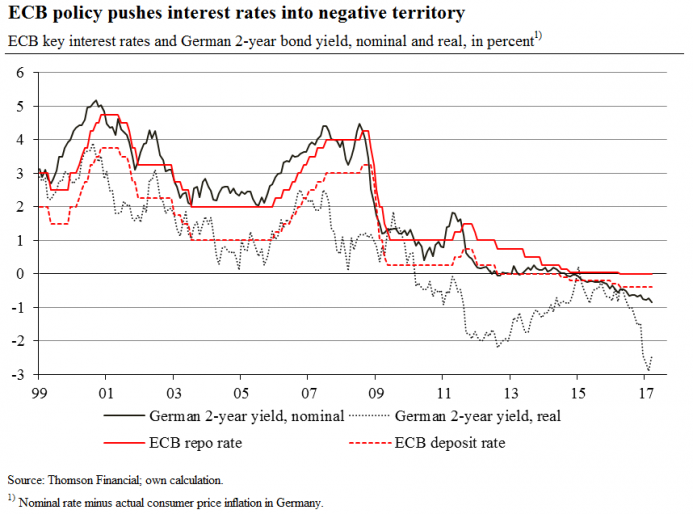Mainstream view of what velocity is
According to popular thinking the idea of velocity is straightforward. It is held that over any interval of time, such as a year, a given amount of money can be used again and again to finance people’s purchases of goods and services. The money one person spends for goods and services at any given moment can be used later by the recipient of that money to purchase yet other goods and services.
For example, during a year a particular ten-dollar bill might have been used as following: a baker John pays the ten-dollars to a tomato farmer George. The tomato farmer uses the ten-dollar bill to buy potatoes from Bob who uses the ten dollar bill to buy sugar from Tom. The ten-dollars here served in three transactions. This means that the ten-dollar bill was used 3 times during the year, its velocity is therefore 3.
A $10 bill, which is circulating with a velocity of ‘3’ financed $30 worth of transactions in that year. Consequently, if there are $3000billion worth of transactions in an economy during a particular year and there is an average money stock of $500 billion during that year, then each dollar of money is used on average 6 times during the year (since 6*$500 billion =$3000).
A $500 billion of money is boosted by means of a velocity factor to become effectively $3000 billion. This implies that the velocity of money can boost the means of finance. From this it is established that
Velocity = Value of transactions / supply of money
This expression can be summarised as
V = P*T/M
Where V stands for velocity, P stands for average prices, T stands for volume of transactions and M stands for the supply of money.
This expression can be further rearranged by multiplying both sides of the equation by M. This in turn will give the famous equation of exchange
M*V = P*T
This equation states that money times velocity equals the value of transactions. Many economists employ GDP instead of P*T thereby concluding that
M*V = GDP = P*(real GDP)
The equation of exchange appears to offer a wealth of information regarding the state of the economy.
It is alleged that when the velocity of money rises all other things being equal, the buying power of money falls ie. the prices of goods and services rise. The opposite occurs when velocity declines.
If for example it was found that the quantity of money has increased by 10 per cent in a given year, while the price level as measured by the consumer price index, has remained unchanged, it would mean that there must have been a slowing down of about 10 per cent in the velocity of circulation.
If the quantity of money has remained unchanged, but there has been a 10 per cent increase in the price level in a given period, it would mean that there must have been an increase in the velocity of circulation of money of 10 per cent in that period.
According to this way of thinking it would appear that velocity is an important determinant of the value of money.
Furthermore, if one were to assume a stable velocity, then for a given stock of money one can establish the value of GDP. Information regarding the average price or the price level allows economists to establish the state of real output and its rate of growth.
The debates that economists have are predominantly with respect to the stability of velocity. If velocity is stable then money becomes a very powerful tool in tracking the economy.
The importance of money as an economic indicator however diminishes once velocity becomes less stable and hence less predictable. It is held an unstable velocity implies an unstable demand for money, which makes it so much harder for the central bank to navigate the economy along the path of economic stability.
Demand for money and velocity
Individuals demand for various goods and services is not set arbitrary but rather consciously and purposefully. People demand food because it offers nourishment which is required to support their lives and well being. Individuals demand for housing stems from the need of having a shelter.
For a good to be demanded by human beings it must have certain features or characteristics which will contribute to human’s well being. So if the main feature of money would have been that it circulates, how would it have been useful to humans? How money velocity would promote people’s well being?
According to Mises the whole concept of velocity is hollow;
In analyzing the equation of exchange one assumes that one of its elements–total supply of money, volume of trade, velocity of circulation–changes, without asking how such changes occur. It is not recognized that changes in these magnitudes do not emerge in the Volkswirtschaft [political economy, or more loosely‘economy’] as such, but in the individual actors’ conditions, and that it is the interplay of the reactions of these actors that results in alterations of the price structure. The mathematical economists refuse to start from the various individuals’ demand for and supply of money. They introduce instead the spurious notion of velocity of circulation fashioned according to the patterns of mechanics (Human Action p 399).
Furthermore money never circulates as such;
Money can be in the process of transportation, it can travel in trains, ships, or planes from one place to another. But it is in this case, too, always subject to somebody’s control, is somebody’s property. (Human Action p 403)
According to Mises, (Human Action p402)
Media of exchange are economic goods. They are scarce; there is a demand for them. There are on the market people who desire to acquire them and are ready to exchange goods and services against them. Media of exchange have value in exchange. People make sacrifices for their acquisition; they pay “prices” for them. The peculiarity of these prices lies merely in the fact that they cannot be expressed in terms of money. In reference to the vendible goods and services we speak of prices or of money prices. In reference to money we speak of its purchasing power with regard to various vendible goods
The main feature of money is that people can employ it as the medium of the exchange. The introduction of money into human lives enables them to expand the production of goods and services by allowing them to specialise. With the existence of money a product of one specialist can be exchanged for the product of another specialist.
Once an individual has exchanged his product for money he can now hold the money until he will decide to exchange it for goods that he requires. Note that by exchanging his goods for money he has exercised a demand for money.
A decision by individuals to buy a certain amount of goods and services means that they have decided to lower their holdings of money. Conversely a decision to sell goods and services implies that they want to raise their holdings of money.
The popular thinking doesn’t deny that money is always under someone’s ownership. However, it is argued, this doesn’t preclude it from being circulated. According to this way of thinking velocity means how fast money changes hands.
Consequently, it is held, that all other things being equal, a rise in the speed of change in money’s ownership leads to higher prices.
A fall in the speed leads to lower prices. It would appear that velocity of money is an existent entity which influences money’s purchasing power.
Money however, cannot change hands without its owner’s decision. Implying that it is individuals demand versus supply that determines the value of money.
The velocity in this case, or how fast money changes hands, is the result of individuals exercising their demands. This in turn means that the so called velocity cannot have any input in the setting of the purchasing power of money for it is not an independent entity.
Furthermore as we have seen, velocity is always P*T divided into money M ie P*T/M.
On this Rothbard wrote (Man Economy and State p 735)
But it is absurd to dignify any quantity with a place in an equation unless it can be defined independently of the other terms in the equation.
Since V is P*T/M it follows that the equation of exchange is reduced to
M*(P*T)/M = P*T, which is reduced to P*T = P*T, and this is not a very interesting truism. It is like stating that $10=$10 and this tautology conveys no new knowledge of economic facts.
Conclusions
Contrary to popular thinking the velocity of money doesn’t have a life of its own. It is not an independent entity and hence it can’t cause anything. The apparent simplicity of the equation of exchange and its consequent widespread acceptance by mainstream economists has been instrumental in the erroneous assessments of the true state of the economy.





Nothing unusual about economists being blinded by their own data…